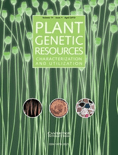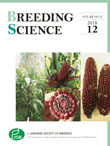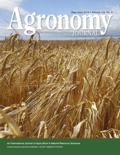
Plant Genetic Resources-Characterization and Utilization
Scope & Guideline
Utilizing Genetic Insights to Sustain Our Ecosystem
Introduction
Aims and Scopes
- Characterization of Plant Genetic Resources:
The journal emphasizes the detailed characterization of various plant genetic resources, including morphological, physiological, and molecular traits to understand the genetic diversity and potential applications in breeding. - Utilization of Genetic Resources in Breeding:
Research focuses on the practical application of genetic resources in breeding programs, aiming to enhance traits such as yield, disease resistance, and stress tolerance in crops. - Diversity Studies Across Species:
The journal covers studies that explore genetic diversity among a wide range of plant species, including wild relatives and traditional varieties, to identify valuable traits for agricultural improvement. - Molecular Techniques in Plant Genetics:
It frequently publishes studies that utilize molecular markers and genomic tools to analyze genetic relationships, population structures, and trait associations, aiding in the precise selection of breeding materials. - Agroecological Adaptation:
Research often addresses the adaptation of plant genetic resources to various agroecological conditions, ensuring the sustainability of crops in changing environments.
Trending and Emerging
- Climate Resilience and Stress Tolerance:
Recent publications emphasize the identification and characterization of genetic resources that confer resilience to climate-related stresses, such as drought and salinity, which are increasingly relevant in the context of global climate change. - Nutritional Quality Enhancement:
There is a growing trend towards enhancing the nutritional quality of crops through genetic improvement, with studies focusing on traits like protein content, micronutrient density, and bioactive compounds. - Integration of Genomics and Bioinformatics:
The use of advanced genomic tools and bioinformatics for genetic analysis is on the rise. This trend reflects a shift towards data-driven approaches in understanding genetic diversity and trait associations. - Conservation of Underutilized Species:
There is an increasing interest in the conservation and utilization of underutilized plant species, recognizing their potential contributions to food security and biodiversity. - Participatory Approaches in Breeding:
Emerging themes also include participatory breeding approaches that engage local communities in the selection and development of crop varieties, ensuring that breeding programs are tailored to local needs and conditions.
Declining or Waning
- Traditional Breeding Techniques:
There is a noticeable decrease in studies that focus solely on traditional breeding methods. The trend has shifted towards integrating molecular techniques and biotechnology, which are perceived as more effective in addressing contemporary agricultural challenges. - Conventional Morphological Assessments:
While morphological assessments remain important, there seems to be a waning interest in purely conventional approaches without molecular validation. Researchers are increasingly favoring integrated methods that combine morphological data with molecular insights. - Regional Focus on Specific Crop Types:
Research concentrating on specific regional crops has declined, possibly due to a broader global emphasis on universal genetic resources that can be applied across various regions and contexts. - Single Trait Analysis:
There is a diminishing emphasis on studies that analyze single traits in isolation. Recent publications favor a more holistic approach, examining multiple traits simultaneously to understand complex interactions in plant genetics.
Similar Journals

HORTICULTURAL SCIENCE
Transforming Horticulture with Cutting-Edge Research.HORTICULTURAL SCIENCE is a premier scholarly journal published by the Czech Academy Agricultural Sciences, focusing on the myriad facets of horticulture, including plant breeding, cultivation techniques, and sustainable practices. With a robust Open Access model established since 2002, it aims to disseminate high-quality research to a global audience, fostering collaboration and innovation within the field. Located in the heart of Prague, Czech Republic, the journal boasts an impressive Q2 ranking in Horticulture as reported in 2023, placing it within the top tier of its discipline. Furthermore, it ranks 52nd out of 115 in the scope of Agricultural and Biological Sciences, reflecting its growing influence and reach in horticultural research. The journal is an essential resource for researchers, professionals, and students alike, aiming to advance knowledge and practices in horticulture through original research articles, reviews, and case studies. With its commitment to academic rigor and relevance, HORTICULTURAL SCIENCE stands as a vital contribution to the ongoing discourse in horticultural studies.

GENETIC RESOURCES AND CROP EVOLUTION
Transforming Agriculture with Cutting-Edge Genetic ResearchGENETIC RESOURCES AND CROP EVOLUTION is a leading academic journal dedicated to the exploration and advancement of genetic resources in agriculture, evolutionary biology, and plant science. Published by Springer in the Netherlands since 1992, this journal aims to foster a greater understanding of the genetic basis of crop evolution and diversity. With a robust impact reflected in its Q2 status in multiple categories, including Agronomy, Ecology, and Plant Science, it ranks impressively within the top quartiles of its fields. As of 2023, it continues to be an essential resource for researchers, professionals, and students who seek to enhance sustainable crop production and biodiversity conservation through innovative genetic methodologies. The journal promotes high-quality, peer-reviewed research that contributes valuable insights into the genetic adaptation of crops in response to environmental changes. While the journal is not open access, its esteemed reputation ensures that the insights it provides reach a wide audience eager to address some of today's most pressing agricultural challenges.

Revista Fitotecnia Mexicana
Cultivating Innovations in Agronomy and Crop ScienceRevista Fitotecnia Mexicana is a prominent academic journal published by the SOC MEXICANA FITOGENETICA, dedicated to advancing knowledge in the fields of agronomy, crop science, genetics, horticulture, and plant science. With its establishment dating back to 2007 and currently running through 2024, this journal serves as an important platform for researchers, professionals, and academic institutions interested in plant genetic resources and agricultural innovations. Although it holds a Q4 quartile ranking in various categories and is positioned within the lower percentiles in Scopus rankings, it provides crucial insights and opportunities for emerging ideas and local research initiatives. Based in Mexico, and with its indexed ISSN 0187-7380, the journal plays an important role in stemming from the rich agricultural heritage of the region. The lack of open access options underscores the depth of curated content provided, making it a valuable resource for professionals seeking to expand their expertise in the sector.

BREEDING SCIENCE
Elevating Knowledge in Crop Science and BreedingBREEDING SCIENCE is a premier journal published by the Japanese Society of Breeding, dedicated to the advancement of knowledge in the disciplines of agronomy, plant science, and genetics. Established in 1993, this influential publication has consistently contributed to the global research community, showcasing high-quality studies that intersect innovative breeding techniques with pressing agricultural challenges. With an esteemed Scopus rank placing it in the top quartile of Agronomy and Crop Science and the second quartile in Plant Science, BREEDING SCIENCE is essential reading for researchers, professionals, and students alike. The journal's reach and rigor are evidenced by its significant presence in leading academic databases, providing insights and advancements that are critical for improved crop production and sustainable practices. Although it does not currently offer open access options, the depth and relevance of its content ensure that it remains a vital resource for those committed to exploring the evolution and impact of breeding science. For further information, readers are encouraged to connect directly with the journal via its administrative office located at the University of Tokyo's Graduate School of Agricultural and Life Sciences.

Crop Breeding and Applied Biotechnology
Empowering crop science with groundbreaking biotechnology insights.Crop Breeding and Applied Biotechnology is a prominent open-access journal published by the Brazilian Society of Plant Breeding that has been dedicated to advancing research in the fields of Agronomy, Crop Science, and Biotechnology since its inception in 2001. With an ISSN of 1984-7033 and an E-ISSN of 1518-7853, this journal is widely recognized within the academic community, evidenced by its Q2 ranking in Agronomy and Crop Science and Q3 ranking in Biotechnology for 2023. The journal serves as a vital platform for researchers, professionals, and students, facilitating the exchange of innovative ideas and studies in crop breeding techniques, genetic improvements, and applied biotechnological advancements. Housed at the Federal University of Viçosa, Brazil, it not only enhances global collaboration among scientists but also contributes to the sustainable development of agricultural practices. As a peer-reviewed journal with a significant indexing presence, it ensures high visibility and accessibility of quality research to the global scientific community.

AGRONOMY JOURNAL
Transforming Agricultural Practices with Cutting-edge ResearchThe Agronomy Journal, published by Wiley, is a leading platform for cutting-edge research in the field of agronomy and crop science. Established in the United States, this prestigious journal carries the ISSN 0002-1962 and E-ISSN 1435-0645, with its coverage spanning from 1976 to 2024, showcasing a wealth of knowledge over decades. The journal is recognized in the top quartile (Q1) of its category, making it a highly respected source for quality literature, ranking #108 out of 406 in the Scopus database and reflecting a 73rd percentile standing in agricultural and biological sciences. While it operates under traditional access options, its commitment to disseminating valuable scientific inquiry aligns with the objectives of advancing sustainable agricultural practices globally. The Agronomy Journal serves as an indispensable resource for researchers, professionals, and students eager to stay abreast of significant advancements and discussions influencing the future of crop science and agronomic research.

INDIAN JOURNAL OF GENETICS AND PLANT BREEDING
Transforming Agriculture with Cutting-edge ResearchIndian Journal of Genetics and Plant Breeding, ISSN 0019-5200, published by the Indian Society of Genetics and Plant Breeding, serves as a pivotal platform for research in the fields of genetics and plant breeding. Based in India, this journal provides valuable insights into the latest developments, methodologies, and findings that drive innovation and enhance the agricultural landscape. With a convergence period extending from 2008 to 2024, this journal maintains a strong focus on advancing our understanding of genetic mechanisms in plants, contributing significantly to both academic circles and practical applications in agriculture. Although presently ranked in the fourth quartile for Genetics and the third quartile for Plant Science, the journal aims to elevate its impact factor and enhance visibility among research communities through rigorous peer-reviewed articles. Published in both print and online formats, the journal is accessible to a global audience and emphasizes the importance of open communication in fostering scientific advancements. Researchers, professionals, and students alike will find this journal an essential resource for staying abreast of trends and breakthroughs in genetic research and plant breeding.

SABRAO Journal of Breeding and Genetics
Exploring breakthroughs in breeding and genetic sciences.SABRAO Journal of Breeding and Genetics is a premier academic platform dedicated to fostering research and dissemination in the fields of agronomy, animal science, biotechnology, and genetics. Published by the SOC ADVANCEMENT BREEDING RESEARCHES ASIA & OCEANIA in Japan, this esteemed journal has an ISSN of 1029-7073 and E-ISSN of 2224-8978. Operating under open access, it aims to enhance the visibility of high-quality research while encouraging innovative advancements in breeding and genetics studies. With remarkable quartile rankings in 2023, including Q3 in Agronomy and Crop Science and Biotechnology, the journal is an essential resource for researchers, professionals, and students aiming to stay informed about the latest scientific developments. Covering diverse topics in a converged timeline from 2008 to 2024, it offers a comprehensive outlook on the challenges and advancements shaping the future of agricultural and biological sciences.

PLANT BIOTECHNOLOGY JOURNAL
Empowering research to transform agriculture and biotechnology.Plant Biotechnology Journal, published by Wiley, is a premier open-access platform dedicated to advancing the field of plant biotechnology. Since its inception in 2003, this journal has played a pivotal role in disseminating high-quality research that enhances our understanding of plant genomics, biochemistry, and molecular biology. With an impressive impact factor and a prominent position in Q1 quartiles across Agronomy, Crop Science, Biotechnology, and Plant Science, it ranks among the top journals globally, reflecting its significant influence in the agricultural and biological sciences. Researchers and professionals can access cutting-edge studies and reviews that facilitate innovation in sustainable crop production and biotechnology applications. The journal's transition to an open access model since 2016 has further amplified its reach, ensuring that vital research is available to a global audience, promoting collaboration and knowledge sharing within the scientific community.

MOLECULAR BREEDING
Catalyzing Discoveries for a Sustainable Agricultural FutureMOLECULAR BREEDING is a prestigious journal published by Springer, dedicated to advancing the field of agronomy, plant science, and biotechnology through innovative research contributions. With an impressive ISSN of 1380-3743 and E-ISSN 1572-9788, this journal has continuously served the scientific community since its inception in 1995. Operating from the Netherlands, MOLECULAR BREEDING is recognized for its high impact factor and status in the Q1 quartile for both Agronomy and Crop Science and Plant Science in the latest 2023 metrics, highlighting its influential role in these domains. With strong Scopus rankings reflecting its position within the top percentiles of various related fields—including a notable 81st percentile in Plant Science—this journal is essential for researchers, professionals, and students striving to understand and innovate in molecular genetics and breeding techniques. Although it does not provide open access, its rigorous peer-review process ensures that published articles maintain the highest standards and contribute significantly to the scientific discourse. The journal’s diverse scope encompasses significant advancements in molecular biology and genetics, ultimately supporting the global objectives of sustainable agriculture and enhanced crop resilience.